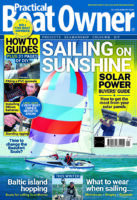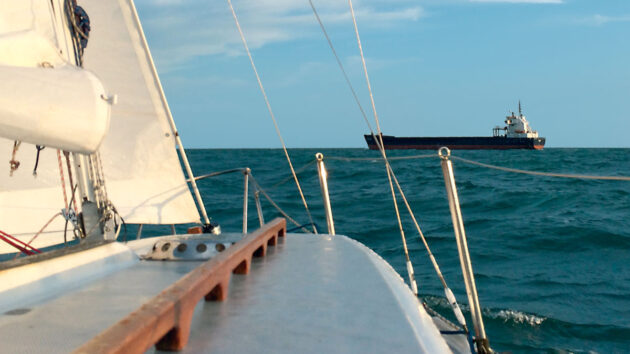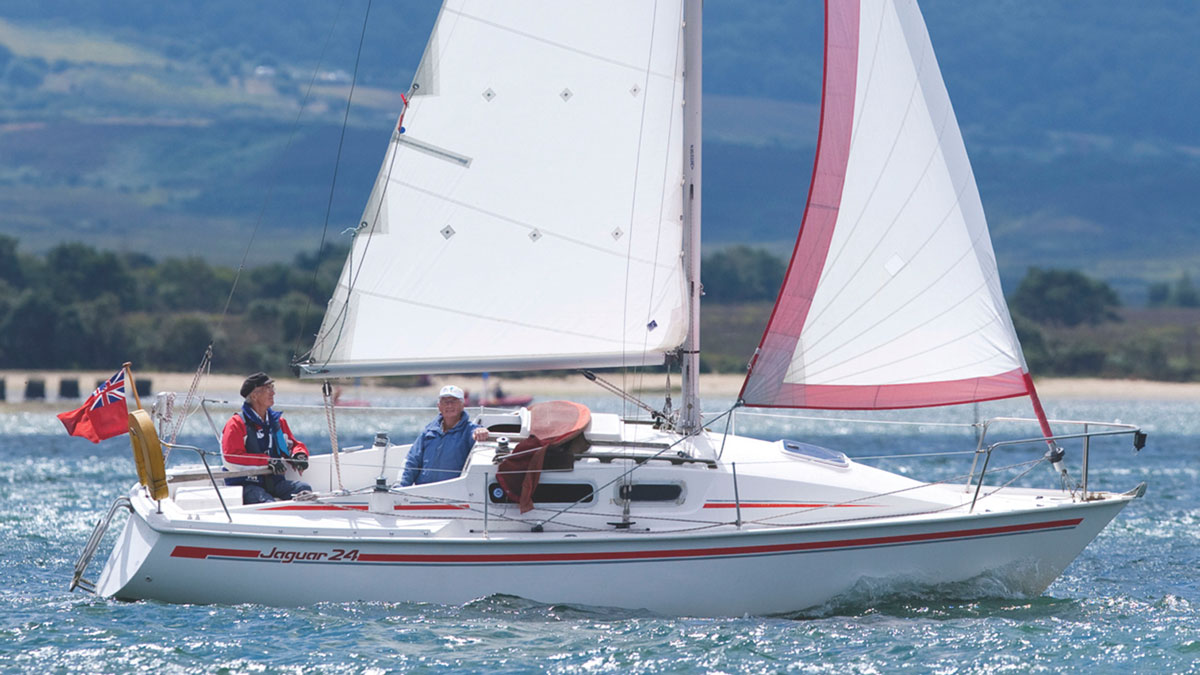Sticky Stapylton explains the meaning and intended purpose of traffic separation schemes – and what you should know if your boat has to enter or leave one
A while back, the Yachtmaster offshore preparation and exam was a seven-day course during which we were assessed by the boat’s bosun, a very experienced Yachtmaster instructor, writes Sticky Stapylton.
On my course, the passage took us east from the Solent to Shoreham and then across the Channel to Fécamp, almost into the Seine estuary, along the Normandy beaches, round the Cotentin peninsula, a foray into the Channel Islands and then back via Weymouth and the western entrance to the Solent. ‘Fings ain’t wot they used to be!’
I was on watch with the skipper of the day for the trip from St Peter Port to Weymouth, and I remember clearing the gap between the Casquets and Alderney and looking over to port: I could see a number of vessels in (and exiting east from) the Casquets TSS north-west of us.
I counted all the vessels I could see in the Traffic Separation Scheme (TSS) and those crossing our bow, and there were 39 of them!

Anatomy of a traffic separation scheme (TSS)
The skipper was not aware of the rules of the road for Traffic Separation Schemes (TSSs) and insisted that all the power-driven vessels should alter course for us as we were under sail.
We had an interesting ‘discussion’. The bosun, whose habit was to kip quietly in a corner of the cockpit, heard our conversation and quietly and firmly confirmed the relevant part of Rule 10 of the International Regulations For Prevention of Collisions at Sea (IRPCS):
RULE 10j – A vessel of less than 20m in length or a sailing vessel shall not impede the safe passage of a power-driven vessel following a traffic lane.
Each Traffic Separation Scheme (TSS) is made up of:
A: Traffic lanes – with directions of travel.
B: Separation zones or lines to keep apart vessels that are moving in different directions.
C: Inshore traffic zones for smaller vessels and vessels engaged in fishing. Larger vessels are required to use the traffic lanes (with some exceptions).
The main objectives of these routeing schemes are to:
- Help reduce and manage head-on situations for the streams of opposing traffic.
- Help to manage crossing situations arising.
- Provide routes for deep-draught vessels.
I have selected the main applications of Rule 10 of IRPCS which relate to Traffic Separation Schemes (TSSs) and which yachtsmen must know, understand and comply with where relevant.
Understanding a Traffic Separation Scheme (TSS) – Keeping to the traffic lanes
Rule 10b – Any vessel using a traffic separation scheme shall: (i) proceed in the appropriate traffic lane in the general direction of traffic flow for that lane.
Here is an extract from a report by the Marine Accident Investigation Branch (MAIB) which highlights how ignorance of a rule, inexperience, failure to keep a proper lookout and loss of situational awareness can lead to collision.
Although this incident did not involve a yacht, it does involve a small vessel.
A general cargo vessel was making way in a busy Traffic Separation Scheme (TSS) at night. A bulk carrier was abaft the vessel’s starboard beam at a distance of 1.7NM and slowly overtaking.
The officer of the watch (OOW) of the general cargo vessel saw another vessel forward, 20° off his starboard bow at 3.9NM and with a closest point of approach (CPA) of 0.1NM.

He did not acquire the vessel on the automatic radar plotting aid (ARPA) or use the automatic identification system (AIS) data to determine the vessel’s name or status.
However, he assessed that the vessel was crossing his bow from starboard to port so he judged his vessel was the give-way vessel, even though he was travelling within the correct part of the Traffic Separation Scheme (TSS).
As it turned out, this was a fishing vessel engaged in fishing, not a crossing vessel. The fishing vessel began to manoeuvre to port to stay away from the commercial traffic, but the officer of the watch on the general cargo vessel did not immediately notice this.
When he did notice the change of course, he was confused as this did not match his mental picture of a vessel crossing the traffic lane.
His response was to continue to alter to starboard, putting the fishing vessel about 30° off his port bow.
By now, he was becoming unsure of what to do – and in the following two minutes, he made several alterations of course to both port and starboard.
He was still unaware that this vessel was a fishing vessel which was manoeuvring out of his way. Remember, all this was happening at night.
The coastguard Traffic Separation Scheme (TSS) services, seeing the movements on radar, became aware that an ambiguous situation was developing and called the office of the watch of the general cargo vessel.
A short conversation ensued and the Traffic Separation Scheme (TSS) services inquired if the general cargo vessel was executing a 360° turn.
Although this was not the officer of the watch’s plan, he replied in the affirmative to Traffic Separation Scheme (TSS) services.
Immediately after this conversation, the officer of the watch selected hand steering and applied 35° starboard helm.
Since the vessel was equipped with a high-lift rudder, the rate of turn increased rapidly. He did not realise that the bulk carrier was now about 500m off his starboard beam.
Meanwhile, the bulk carrier’s officer of the watch had also been contacted by the Traffic Separation Scheme (TSS) services, and after a short conversation, this officer of the watch ordered hard port helm.
Although he had been monitoring and was now aware that the general cargo was to execute a 360° turn, he did not think this manoeuvre was already under way.
He assumed that the general cargo would pass ahead before starting the 360° turn: but within seconds he noticed that the cargo vessel was turning quickly towards him, so he immediately ordered hard starboard helm.
Nonetheless, soon afterwards, the two vessels collided.
Lessons learned
- Although the fishing vessel had started to alter course in order to clear the traffic lane and avoid impeding the safe passage of the two larger vessels, this alteration was not seen by the general cargo vessel’s officer of the watch for over five minutes. This implies that the general cargo vessel’s officer of the watch was neither keeping a proper visual lookout nor effectively using the electronic aids available.
- The intervention on VHF radio by the coast watch officer was timely, appropriate and well-intended. However, because of the language used, it unintentionally influenced the decision-making of the general cargo vessel’s officer of the watch and prompted him to improvise a 360° turn, unwittingly turning towards the bulk carrier.
- The general cargo vessel’s officer of the watch suffered a complete loss of situational awareness. He was unaware of the proximity of the bulk carrier until the vessels collided.
- The general cargo vessel’s officer of the watch was very inexperienced, as shown by his inability to make sense of the fishing vessel’s actions and his total loss (or lack) of situational awareness. He had not yet developed sufficient competency to keep a bridge watch in a busy Traffic Separation Scheme (TSS) at night by himself.
- As it turned out, the general cargo vessel’s officer of the watch had only been in charge of 10 bridge watches before the accident, and the master had only known him for about two weeks. It is not known why the master was sufficiently confident of the officer of the watch’s abilities as to entrust him with the bridge watch in such a congested area at night.
Rule 10b (ii) – Any vessel, so far as is practicable, must keep clear of a traffic separation line or separation zone.
So, as a yachtsman, if I can avoid going near a Traffic Separation Scheme (TSS), I will do so.
However, if I am going to cross the Channel there are going to be quite a few routes which will either cross or go close to a Traffic Separation Scheme (TSS), so not only is the ‘situational awareness’ mentioned above all-important, but we must also understand that there may be inexperienced watchkeepers alone on the bridges of large vessels.
Joining or leaving a Traffic Separation Scheme (TSS)
Rule 10b (iii) – Any vessel using a Traffic Separation Scheme (TSS) shall normally join or leave a traffic lane at the termination of the lane, but when joining or leaving from either side shall do so at as small an angle to the general direction of traffic flow as practicable.

Crossing at right angles to traffic flow
Rule 10c – A vessel shall, so far as is practicable, avoid crossing traffic lanes – but if obliged to do so shall cross on a heading as nearly as practicable at
right angles to the general direction of traffic flow.

So, crossing vessels must ignore wind and tide and present the beam of the vessel to the traffic which is following the Traffic Separation Scheme (TSS) lanes.
Avoiding separation zones
Sailors crossing a Traffic Separation Scheme (TSS) should be aware of Rule 10e:
A vessel other than a crossing vessel or a vessel joining or leaving a lane shall not normally enter a separation zone or cross a separation line except: in cases of emergency to avoid immediate danger or to engage in fishing within a separation zone.
So if, as a sailor, you find yourself in difficulty and close to the separation zone, it is essential that you sort out your problem in the separation zone and keep out of the Traffic Separation Scheme (TSS).
AIS is an excellent aid in that it will give you all the identification information so that you can contact other vessels.

The illustration above shows all the AIS transmissions in the Channel at one given moment.
By placing the cursor over any one target, a screen will come up with the following useful information of the targeted vessel – call sign; length, beam and draught; MMSI; whether under way or not; speed; position; course.
Other parts of Rule 10 relevant to sailors are:
Rule 10g – A vessel shall so far as practicable avoid anchoring in a traffic separation scheme or in areas near its terminations.
Rule 10h – A vessel not using a traffic separation scheme shall avoid it by as wide a margin as is practicable.
Whenever I cross the English Channel, particularly with an inexperienced crew, I plan to be on watch and awake for the whole period of crossing the main shipping lanes and, in particular, the Traffic Separation Scheme (TSS).
With any crew of experience, I brief them on the importance of lookout, especially our blind spot areas – and in the case of any doubt whatsoever, I am to be woken immediately.
My cardinal rule is that any vessel at a distance is to be monitored for being on a constant bearing, and allowance made for the fact that there may be only one man on watch on large vessels: the vessel will be on autopilot, and he may be making himself a cup of tea while closing our course line.
And finally…
All these rules may sound a bit daunting to the sailing the the area of Traffic Separation Scheme (TSS) for the first time.

Keeping a lookout is vitally important, particularly regarding blind spot areas
The important things to remember are:
- Lookout is essential
- Ideally, an experienced sailor should always be on deck
- Know the rules
- If you are the give-way vessel, take action as soon as you realise that you have to change course – the earlier the better.
- At night, when changing course, try to show a change of lowlight or tricolour colour. This may mean a tack, but showing a change of light indicates to the stand-on vessel that you have taken the proper action.
- If you have AIS and radar, use them! If you want to talk to another vessel, bear in mind they may be switched to the VTS channel (often Ch11) so you may not get a response on Ch16. AIS will give you a vessel’s MMSI (Maritime Mobile Service Identity) so you can call the skipper on DSC radio more easily.
Seamanship tips from a seasoned sailing instructor
Sticky Stapylton has sailed thousands of miles and taught numerous people how to sail. He shares some of his seamanship…
Fouled propeller fix: top tips for solving the problem at sea
What should you do when you catch a line or fishing net and your prop becomes fouled? Ali Wood looks…
Crossing the Channel: 10 factors for a trouble-free voyage
What could go wrong while crossing the Channel? Ken Endean considers possible difficulties
Berthing a vessel: 2 clever ways with warps
In these days of fin keels, bow-thrusters and powerful engines, using warps for marina manoeuvres might seem an old-fashioned irrelevance…
Want to read more articles like How to cross a Traffic Separation Scheme?

A subscription to Practical Boat Owner magazine costs around 40% less than the cover price.
Print and digital editions are available through Magazines Direct – where you can also find the latest deals.
PBO is packed with information to help you get the most from boat ownership – whether sail or power.
-
-
-
- Take your DIY skills to the next level with trusted advice on boat maintenance and repairs
- Impartial, in-depth gear reviews
- Practical cruising tips for making the most of your time afloat
-
-
Follow us on Facebook, Instagram, TikTok and Twitter








